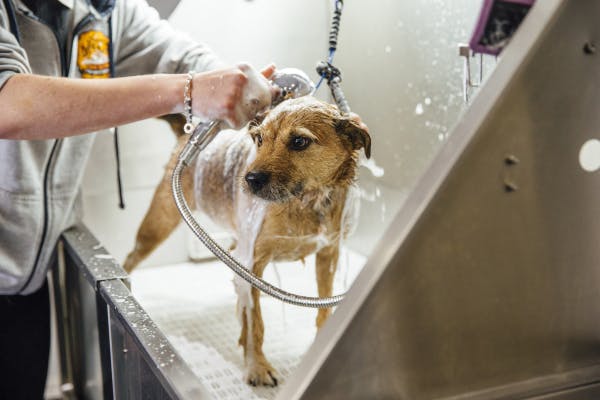Flea Treatment in U.S.A
Best Flea Treatment For Dogs
The best flea treatment for dogs depends on various factors including breed, size, age, and health. Topical treatments can offer a month of protection while oral treatments can eliminate fleas quickly. Flea collars provide long-lasting protection, and flea sprays treat the dog's environment.
Why You Should Trust Us
Handpicked flea treatment. Our expert researchers, data analysts, and editors have put more than 30 hours of effort into researching the best available flea treatment for dogs in the United States. We had researched 357 flea treatment sold in 5 countries before handpicking the 20 best flea treatment for dogs.
- Hours Researched
- 30+
- Products Researched
- 357
- Products Handpicked
- 20
- Acceptance Rate
- 5.6%
How to choose The Best flea treatment:
When choosing the best flea treatment for your dog, the most effective options are those that kill fleas on contact. This means the flea doesn't need to bite your dog for the treatment to work. This is an essential feature as it not only tackles the existing infestation, but also provides a layer of protection, preventing future bites and potential health complications.
An ideal flea treatment should also be long-lasting. Top-quality products offer protection for at least a month, and some can even last up to three months. This feature is beneficial as it saves you from having to frequently reapply the treatment, which can be stressful for both you and your pet.
Another vital aspect to consider is whether the product targets multiple stages of the flea life cycle - from eggs and larvae to pupae and adults. By doing this, it interrupts the life cycle of fleas, ensuring complete eradication of these bothersome pests.
It's also crucial to ensure that the product is safe for your pet. The best flea treatments are recommended by vets and have undergone thorough testing to ensure they won't cause any adverse reactions or side effects. They should be appropriate for dogs of all sizes and breeds unless otherwise specified.
Lastly, consider the ease of application. Whether it's a topical solution or an oral medication, it should be straightforward to administer without causing discomfort to your pet. By investing in a high-quality flea treatment, you're not only getting rid of these annoying pests; you're ensuring the comfort and health of your dog.
4 types of flea treatment for dogs:
common questions about flea treatment:
- What is the best way to treat fleas in dogs?
- What could be the possible side effects of using flea treatments on dogs?
- Do flea treatments for dogs also treat other parasites?
- What factors should be taken into account when selecting a flea treatment for my dog?
- What are some natural alternatives to synthetic flea treatments for dogs?
- Should I treat my dog for fleas even if they don't have any?
Flea Collars
- our rating94 out of 100
- our rating91 out of 100
- our rating86 out of 100
Flea collars for dogs have numerous benefits:
Long-lasting protection: These collars can shield dogs from fleas and ticks for many months, even up to eight months in certain instances, providing a handy solution for prolonged pest control.
Ease of use: Flea collars are straightforward to apply. Simply place the collar around the dog's neck and adjust for a snug fit. Unlike other flea treatments, there's no need for monthly applications.
Cost-effectiveness: Compared to other flea treatments that need frequent purchases and applications, flea collars can be more economical due to their long lifespan.
Dual functionality: Some flea collars not only deter fleas but also exterminate them, offering both preventative and healing solutions.
Broad coverage: The collar's chemicals spread across the dog's body through their natural oils, offering extensive protection against pests.
No mess: Flea collars leave no residue on your pet's fur or skin unlike topical treatments.
However, it should be noted that a flea collar's effectiveness can vary based on factors like the brand and your pet's specific requirements. It is essential to read the product description thoroughly to ensure you choose a collar that meets your pet's needs.
Learn About Flea Collars
Flea Pills
- our rating72 out of 100
- our rating69 out of 100
- our rating68 out of 100
There are numerous types of flea pills for dogs, each with distinct active ingredients that address fleas in various ways. Here are some common ones:
Nitenpyram: This oral treatment kills adult fleas on dogs rapidly. This formula begins working in 30 minutes, offering up to 24 hours of flea protection.
Imidacloprid: These pills are quickly absorbed, offering prompt and effective relief from flea infestations.
Isoxazoline: These newer pills kill the flea once it bites your dog by affecting its nervous system.
Lufenuron: This ingredient prevents flea eggs from hatching but does not work against ticks.
Before choosing a flea pill for your dog, it's crucial to speak with a veterinarian because some breeds may be more susceptible to certain medications' side effects, and some medications may negatively interact with other treatments your dog is receiving.
Learn About Flea Pills
Flea Medicine Drops
- our rating88 out of 100
- our rating87 out of 100
- our rating77 out of 100
Dog flea treatments contain multiple active ingredients to tackle fleas at various life stages. The primary ones include:
Fipronil: A widespread insecticide in many spot-on treatments, it rapidly kills live fleas and acts as a preventative measure.
Imidacloprid: This swift-acting systemic insecticide, an alternative to Fipronil, also exterminates adult fleas.
S-Methoprene: An insect growth regulator that mimics an insect hormone, disrupting growth and development to halt the flea life cycle.
Pyriproxyfen: Another insect growth regulator impacting various insects, including fleas..
Etofenprox: A safe synthetic pyrethroid for dogs and cats.
Piperonyl Butoxide (PBO): A synthetic pesticide that enhances the potency of other insect-killing ingredients.
N-Octyl Bicycloheptene Dicarboximide (MGK 264): An insecticide synergist that boosts the efficiency of other pesticides.
Dinotefuran: A neonicotinoid that binds to insect acetylcholine receptor sites, causing paralysis and death by inhibiting insect nervous system function.
Permethrin: An ingredient in household flea sprays that controls insects by affecting their nervous system.
Tetramethrin: A synthetic insecticide for indoor pest control.
D-Phenothrin: An insecticide used in homes, commercial environments, and pet products.
Different combinations of these active ingredients are used in each product, impacting their effectiveness and the stages of the flea life cycle they target.
Learn About Flea Medicine Drops
Flea Spray
- our rating83 out of 100
- our rating78 out of 100
- our rating78 out of 100
Flea sprays for dogs are created to eliminate fleas, which are common pests that can cause discomfort and health issues in dogs.
The benefits of using flea sprays are:
Flea Control: These sprays can effectively kill adult fleas on the dog, disrupting the life cycle of the pests.
Disease Prevention: By controlling fleas, the sprays can help prevent diseases carried by these pests, such as tapeworms and flea allergy dermatitis.
Ease of Use: Flea sprays are generally easy to use. They can be sprayed directly onto the dog's fur, reaching areas where fleas hide.
However, there can be potential drawbacks to using flea sprays:
Skin Irritation: Some dogs may experience skin irritation or allergic reactions to the chemicals in flea sprays, resulting in redness, itching, and discomfort.
Toxicity: If swallowed, some chemicals in flea sprays can be toxic to dogs. Symptoms of toxicity may include vomiting, tremors, seizures, and in severe cases, death.
Impact on Humans and Other Pets: Humans and other pets who have close contact with dogs treated with these chemicals could also be affected by the toxins.
Resistance: Some fleas may become resistant to certain chemicals used in flea sprays, making them ineffective over time.
Pet owners should always consult with their vet before choosing a method for flea control. Carefully reading product labels and following instructions can help reduce potential side effects.
Learn About Flea Spray
Questions About Flea Treatment
What is the best way to treat fleas in dogs?
The optimal flea treatment for dogs varies based on factors like breed, size, age, health, and infestation severity. Notwithstanding, some effective methods are:
Topical Treatments: Directly applied to the dog's skin, these offer around a month of protection.
Oral Treatments: Consumed by the dog, these can eliminate fleas quickly.
Flea Collars: Provide long-lasting protection against fleas and other pests.
Flea Sprays: Used to treat the dog's environment and kill fleas on contact.
Chewable Treatments: Consumed by the dog, these can provide immediate relief from infestations.
Before starting any flea treatment regimen, it's crucial to seek advice from a veterinarian who can provide guidance tailored to the dog's specific needs.
What could be the possible side effects of using flea treatments on dogs?
Flea treatments for dogs, especially oral and topical medications, can potentially lead to various side effects, ranging from mild to severe, and occasionally, they can be fatal.
Oral Flea and Tick Medicines: These drugs contain isoxazolines and are absorbed into the dog's bloodstream. The FDA has cautioned that these medications might cause neurological harm in dogs, including muscle tremors, impaired movement, lack of coordination, and seizures.
Flea and Tick Collars: These collars emit chemicals into the dog's skin and bloodstream. If accidentally ingested, they could lead to toxicity. The EPA has reported cases of pet deaths and injuries associated with these collars.
Topical Flea and Tick Drugs: These treatments include pyrethrins or pyrethroids, which can be harmful if used in large amounts. High doses could lead to toxicity in dogs, with symptoms such as tremors, twitching, difficulty standing or walking, weakness, seizures, and in extreme cases, death.
Isoxazoline-containing Preventives: An overdose of these drugs can result in muscle tremors, difficulty standing or walking, and seizures.
Natural or Organic Alternatives: Even natural or organic options like essential oils can cause severe adverse reactions in dogs. Side effects may include skin irritation, agitation or lethargy, vomiting, tremors, and seizures.
In any situation where a dog exhibits signs of an adverse reaction to a flea treatment product, it is vital to get veterinary help immediately.
Do flea treatments for dogs also treat other parasites?
Yes, certain flea treatments for dogs also combat other parasites. But remember, not every flea treatment offers a wide range of protection. Always consult a veterinarian to pick the right product tailored to your dog's specific needs and conditions.
What factors should be taken into account when selecting a flea treatment for my dog?
When choosing a flea treatment for your dog, consider these factors:
Treatment Type: Flea treatments come in different forms such as collars, drops, oral products, sprays, and shampoos. Each has its advantages and disadvantages. For instance, collars offer long-term protection but may be more expensive initially. Drops are easy to apply and can protect against other parasites. Oral products work fast but need regular administration.
Effectiveness: The chosen product should effectively kill or repel fleas at all life stages - from eggs to adults.
Safety: The product should be safe for your dog to use with minimal side effects. Consider your dog's age, size, breed, health condition, and any known allergies.
Ease of Use: Think about how easy it is to give the treatment. If giving oral medication is challenging for you, a topical treatment might be a better choice.
Application Frequency: Some treatments require monthly application while others last for several months. Think about how often you can realistically apply the treatment.
Extra Parasite Protection: Some flea treatments also protect against other parasites like ticks, mosquitoes or lice.
Cost: Consider if the cost of the product fits within your budget.
Prescription vs Over-the-Counter: Some flea treatments can be bought over-the-counter while others need a veterinary prescription.
Always remember that the best choice will depend on your specific pet and situation. Always consult with a vet before starting any new treatment for your pet.
What are some natural alternatives to synthetic flea treatments for dogs?
Indeed, there are numerous natural options to manage fleas in dogs. These include:
Enhancing your pet's health: Fleas often prefer less healthy hosts. A balanced, nutritious diet can boost your pet's immunity, making them less appealing to fleas.
Garlic and B-vitamins: These can deter fleas by making the blood less appealing. However, some pets may be allergic to these supplements.
Flea comb: Regular grooming with a flea comb can help eradicate fleas from your pet's coat.
Essential oil products: Products with essential oils like peppermint and clove can aid in repelling fleas.
Frequent cleaning: Regularly washing your pet's bedding in hot soapy water and vacuuming floors and furniture can help remove any flea eggs or larvae.
Beneficial nematodes: These worms consume flea larvae and can be introduced into your yard or garden where your pet frequents.
Diatomaceous earth: This less toxic option for the home and yard can eliminate fleas, but should be used carefully as it can cause harm if inhaled or if it enters your or your pet's eyes.
However, these natural methods may not be effective for all pets or severe infestations. It is always advisable to seek a vet's guidance to create a tailored plan for your pet's flea management needs.
Should I treat my dog for fleas even if they don't have any?
Opinions differ on whether to treat a dog for fleas only when an infestation occurs or to use preventative measures. Andrew Prentis, from the British Veterinary Association, states it's safe and eco-friendly to wait until a pet has fleas before treating. Yet, he admits that in some rare cases, this could lead to severe illness. Thus, consulting with a vet about the best approach for each pet and environment is advised.
Not preventing fleas can make eradication more challenging once an infestation happens. Flea infestations can cause health issues in pets like tapeworms and skin allergies, so some vets suggest regular preventative treatments.
The decision to treat a dog for fleas before they have any depends on the dog's health, lifestyle, and environmental factors. It is wise to get personalized advice from a vet.























